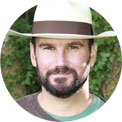Inspiration • May 2014
Can clouds save you from getting lost?
With technology at our fingertips, it’s easy to rely on smartphones to get around. But what if you find yourself with a dead battery? Not a problem, says Tristan Gooley, aka the Natural Navigator. Whether you’re in the city or the desert, just let nature be your sat nav
Natural navigation is the art of finding our way using the sun, moon, stars, weather, plants and animals. A question I get asked a lot is, ‘Do we really have any need for natural navigation now that even our phones have maps and a GPS?’ I answer with a question of my own, ‘Is there any point in good cooking now that we have fast food?’
Using the natural signs around you is not always necessary if all you want to do is get from A to B; but it is vital if you want to have the most interesting journey from A to B. Here’s how to get started using nature as your guide.
Clouds
Every cloud can be used to navigate with practice. But one of the quickest techniques is to look for trends in contrails (aircraft vapour trails). When the atmospheric conditions are right, high aircraft leave long white trails of condensed water vapour. There will be consistent trends in these lines, as there are dependable patterns in the places aircraft fly. Once you know the trend in your area, these contrails act like compasses in the sky. In northwest Europe, they tend to form lines from northwest to southeast.

Cities
If you are totally lost in a big city, go against the flow of people in the morning or with the flow of people in the afternoon, and you will find a station. TV satellite dishes are also very helpful, as they have consistent trends and point to the same satellite in each country – for example, in the UK, nearly all dishes point close to southeast.

Sun
Understanding exactly what direction the sun will be all day takes practice, but everyone in Europe and the US should be aware that it is due south when it is highest in the sky, in the middle of the day. This is why you will find more puddles on the shaded southern side of most west-east tracks than the northern side, where the sun reaches easily in the middle of the day.

Wind
The wind leaves footprints everywhere on Earth. From the middle of the Atlantic, where the ocean swell can be read, to the way the tops of trees are bent by prevailing winds, the wind is there to help navigators. I have used this technique in deserts, on icy mountains, 1,000 miles from land, and in the English countryside. Make sure you stay tuned to the direction the winds have been blowing from and you will find compasses all around you.

Stars
There are hundreds of different ways you can use the stars to navigate, most of which depend on being able to recognise simple shapes in the night sky. With practice, the constellations Auriga, Cassiopeia, Ursa Major, Cygnus and Orion can all be used to find the North Star. There is one simple technique that you can use without needing to know any shapes or names at all. If the stars you see near the horizon rise with time, you are looking east; if they sink, you are looking west.

Tristan’s latest book, The Walker’s Guide To Outdoor Clues and Signs, published by Sceptre, is out on 8 May
This article has been tagged Adventure, Travel Tips
